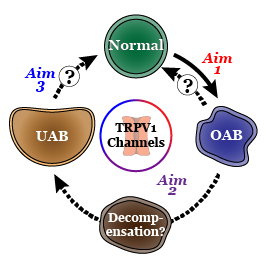TRPV1 Channels as the Linchpin of Stress-induced Bladder Dysfunction in Children
Childhood stress–induced bladder dysfunction, or SIBD, is a major problem leading to major medical, social, emotional and behavioral consequences. We discovered that the TRPV1 channel — best known as the “capsaicin receptor” — is key to the onset and progression of SIBD. We focus on the role of TRPV1 and its effect on sensory nerve activity and bladder remodeling, as well as a possible target for treatment of SIBD.

We are investigating how the duration/intensity of social stress causes bladder dysfunction to determine the role TRPV1 channels play in the progression of SIBD. We use a wide array of techniques and an array of transgenic and knockout mouse models to explore the pathophysiology of SIBD and determine how TRPV1 channels bladder sensation and function. The idea that both bladder overactivity and underactivity develop from aberrant TRPV1 channel sensitization simplifies our understanding of how stress causes bladder dysfunction and may lead to effective treatments for this debilitating condition.
How does this happen? One of our most surprising findings was that knockout of
TRPV1 channels prevented the development of all forms of SIBD entirely. Is SIBD driven by TRPV1-mediated effects in the sensory nerves? Or are TRPV1 channels expressed elsewhere in the lower urinary tract, where they serve to regulate stress-dependent responses? The goal of this project is to answer these questions — and find new therapeutic options for the treatment of this disease. (Links to our paper can be found in our Publications.)